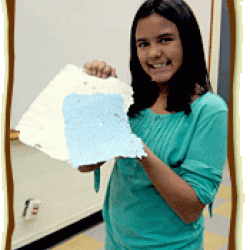Source Institutions
Source Institutions
Add to list Go to activity
Activity link broken? See if it's at the internet archive

The Chinese invented paper made from plants and cloth about 2,000 years ago. Learners follow a similar process to make paper from recycled paper. Once dry, learners can make something special with their handmade paper like a greeting card, origami, a book, or bookmarks. Use this activity to introduce learners to the paper-making process, material science, and/or recycling. Note: adult supervision is recommended to assist learners with scissors, craft knife, and blender.
- Under 5 minutes
- 4 to 24 hours
- $5 - $10 per student
- Ages 8 - 14
- Activity
- English
Quick Guide
Materials List (per student)
- large disposable aluminum pan or plastic bin (bigger than 13" x 9")
- smaller disposable aluminum pans (13" x 9" or smaller)
- fiberglass screen (enough to cut two or more screens the size of the smaller pan bottoms)
- scissors or craft knife
- scrap paper (any used paper, tissue paper, construction paper, or paper towels)
- large bowl or plastic bin (for soaking)
- blender
- sponge
- packing or other wide masking tape
- owels and newspapers (for drying)
- apron, smock, or old clothes
- rolling pin (optional)
- dried flowers, herbs, glitter, short pieces of thread (for decoration and texture) (optional)
Subjects
-
Engineering and Technology
-
Technology
- Information and Communication
-
Technology
-
The Nature of Technology
-
Technology and Society
- Impacts of Technology
- Technology and History
-
The Design Process
- Invention and Innovation
-
Technology and Society
Informal Categories
- Arts and Crafts
Audience
To use this activity, learners need to:
- see
- touch
Learning styles supported:
- Links STEM to other topics of interest such as arts and humanities
- Involves hands-on or lab activities
Other
This resource is part of:
Access Rights:
- Free access
By:
Source Collection
- Ology
Rights:
- All rights reserved, American Museum of Natural History,
